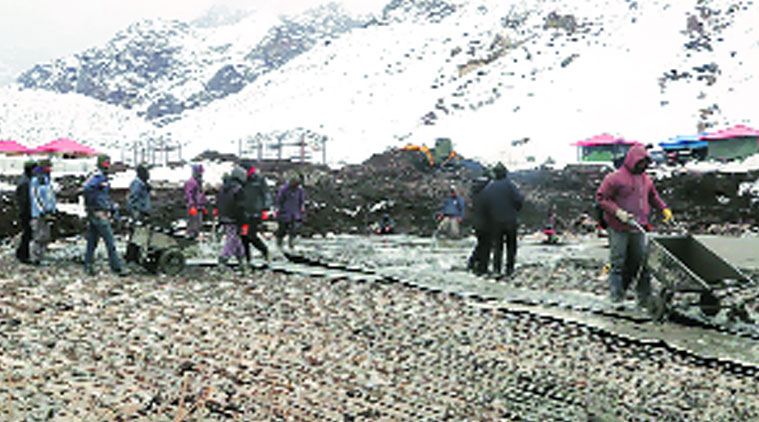- India
- International
The men rebuilding Kedarnath
Padam Shahi and his team from Nepal have helped build helipad to airlift machines.
 Padam Shahi’s men worked for four months to build the helipad. (Source photo Sanjay Singh)
Padam Shahi’s men worked for four months to build the helipad. (Source photo Sanjay Singh)
In Kedarnath, Uttarkhand, the mercury has plunged to —1.3 degree C and the newly constructed helipad is surrounded by a three-foot-thick blanket of snow. At 150 metres by 50 metres, it is much larger than the other helipads in Kedarnath, most of which measure 18 by 36 metres. This means it can be used for landing of IAF’s Mi-26 helicopters, which can carry heavy construction equipment to rebuild homes destroyed in Kedarnath during the 2013 Uttarakhand flash floods.
“The Mi-26 would carry two JCB-3DX, three Poclain machines, one Load Career Hydraulic Truck and two Lift All Hydra (Cranes) in the first phase. These machines are to be airlifted to Kedarnath by the end of December,” Colonel Ajay Kotiyal, principal of Uttarkashi-based Nehru Institute of Mountaineering (NIM), says.
The institute, tasked with building the helipad since August 18, formally communicated to the IAF headquarters on Friday that they had completed the work. “Wing Commander Tung and Bajwa would fly to Kedarnath by Mi-26. Before landing there, the pilots would reach Kedarnath by Advance Light Helicopter to see the helipad,” Kotiyal says.
Behind this grand construction is the story of Padam Shahi, a petite man who, during the four months and three days of the helipad’s construction, has been determined not to miss his deadline.
At 9 am on December 24, two days before the deadline, he assembles his team of 400 labourers and issues instructions to finish work on the helipad, 250 metres from Kedarnath temple, by the evening. With a walkie-talkie in hand, Shahi switches between Hindi and Nepali as he divides his labourers into groups and assigns them different tasks — clearing snow from the area, preparing concrete and laying iron rods. “We’ve completed 95 per cent of the work. We should be able to do the rest too today,” says the 43-year-old.

Shahi is the “meth” or head of labourers — all from Nepal. He was asked by NIM to source labourers to construct the helipad, including transporting five tractors, two JCB-2DX machines, 6 all terrain vehicles and excavator machines, 18,000 bags of cement and 3,000 quintal of iron rods to the site from Sonprayag taking the 25-km trek route. The labourers would dismantle the tractors and the machines at Sonprayag, carry the individual parts along the trek route, and the assemble the machines at the construction site.
Shahi is well-known at NIM and among tourist operators as a reliable porter and at the Uttarakhand PWD as a ready labour supplier. “We, Nepalis, are preferred over others to work at high altitudes. We also like to serve Kedarnath as we are from the land of Pashupatinathji and are devotees of lord Shiva,” he says.
For the last seven years, Shahi has been shuttling between Uttarakhand and his native Batisha village in Nepal, where his wife and three children live. He spends nine months in Uttarakhand working as a porter for Char Dham yatra pilgrims or NIM students and as supervisor of Nepali labourers working on road projects. Following the June 2013 Uttarakhand flash floods, he and his team of labourers were engaged in building a new trekking route in Kedarnath. Shahi. “We live in makeshift tin sheds at the work site,” he says.
Currently, Shahi and other labourers are staying at the Garhwal Mandal Vikas Nigam guest house, 200 metres from the helipad, and other government buildings. It’s off-season and all workers of the guest house are away. Shahi has even got cooks and ironsmiths from his country. “It is now like mini-Nepal here. They also enjoy Nepali songs and movies on TV,” he says.
But it’s still a tough life. Shahi wakes up at 5 am every day and ensures hot water is flowing from the pipes connected to the solar energy system. Then, he and his men help the 10 cooks prepare a quick breakfast — dalia and mandua ki roti — so they are at work by 9 am. The path between the guest house and the helipad is filled with snow, which they have to clear. At the site, each worker gets a health check up.
At the end of the day, he calls his wife. He spends Rs 1,200 a month on the education of his two sons — one is five, the other three. His daughter is two and doesn’t go to school. Shahi is an illiterate and is paid Rs 900 daily, but takes pride in his work. “I want to be remembered for having contributed to the reconstruction of this temple town,” he says.
Apr 19: Latest News
- 01
- 02
- 03
- 04
- 05






































